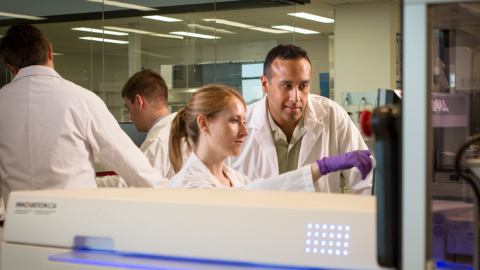Scientific Breakthrough Turns Blood Cells Into Neurons and Advances the Study of Pain

Currently, scientists and physicians have a limited understanding of the complex issue of pain and how to treat it. Pain or numbness is perceived by the brain using signals sent by the peripheral nervous system and it is hard to determine how a person’s nervous system cells react and respond to stimuli. While it is relatively easy to collect a blood or a skin sample or even a tissue biopsy, it is not possible to sample portions of a patient’s neural system. A recent breakthrough finds a way around this problem.
A team of stem cell scientists at McMaster University has discovered how to directly convert adult human blood cells into both central nervous system (brain and spinal cord) neurons as well as neurons in the peripheral nervous system (rest of the body) that are responsible for pain, temperature, and itch perception.
“[Now] we can actually take a patient’s blood sample, as routinely performed in a doctor’s office, and with it we can produce 1 million sensory neurons that make up the peripheral nerves in short order with this new approach. We can also make central nervous system cells, as the blood-to-neural-conversion technology we developed creates neural stem cells during the process of conversion. Nobody has ever done this with adult blood. Ever,” said Mick Bhatia, director of the McMaster Stem Cell and Cancer Research Institute.
The team’s revolutionary, patented direct-conversion technology has “broad and immediate applications.” It can help scientists answer questions like: Why is it that certain people feel pain versus numbness? Is this something genetic? Can the neuropathy that diabetic patients experience be mimicked in a dish?
It also paves the way for the discovery of new pain drugs that don’t just numb the perception of pain. It will help scientists understand the response of cells to different drugs and different stimulation responses, and allow them to provide individualized or personalized medical therapy.
“Up until now, no one’s had the ability and required technology to actually test different drugs to find something that targets the peripheral nervous system and not the central nervous system in a patient-specific, or personalized manner,” adds Bhatia.
In addition:
“Bhatia’s team successfully tested their process using fresh blood, but also cryopreserved (frozen) blood. Since blood samples are taken and frozen with many clinical trials, this allows them ‘almost a bit of a time machine’ to go back and explore questions around pain or neuropathy to run tests on neurons created from blood samples of patients taken in past clinical trials where responses and outcomes have already been recorded.
In the future, the process may have prognostic potential, explained Bhatia, in that one might be able to look at a patient with Type 2 Diabetes and predict whether they will experience neuropathy by running tests in the lab using their own neural cells derived from their blood sample.”
via ScienceDaily
photo: McMaster University





